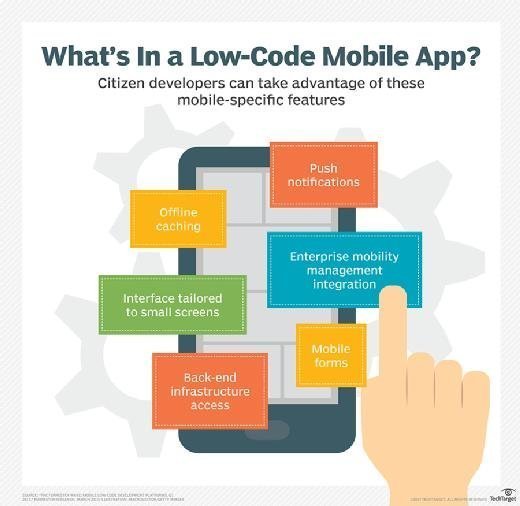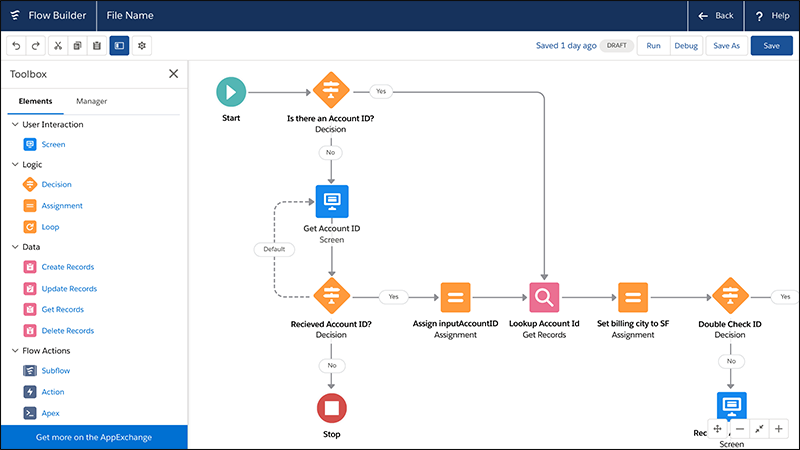New Tips On Choosing Low-Code Platform Examples
New Tips On Choosing Low-Code Platform Examples
Blog Article
Speed-Wise Low-Code Applications Have Many Advantages.
Development of low-code applications significantly increases development speed due to several important factors. Development Environment:
Drag-and-Drop Interfaces: Low-code platforms provide visual tools for designing applications. Drag-and-drop tools enable developers to rapidly build applications without the need to write long lines of code.
Pre-built components and templates Low-code platforms include pre-built components and templates, which allow developers to rapidly prototype and build applications.
Reduction of Coding Requirements
Automated Code Generation: The low-code platform generates the code beneath based on the visual models that developers design. This reduces manual coding, and accelerates the development process.
Reusable component: Developers may utilize the same components on different projects. This cuts down time spent developing code and testing.
Collaboration is streamlined:
Integrated Development Tools: Low-code platforms usually come with tools for version control, testing, and deployment that allow seamless collaboration between development teams.
Citizen Development - Business users, non-developers and other stakeholders can all contribute to application creation through user interfaces that are intuitive. This reduces the bottleneck caused by the lack of availability of skilled developers.
Rapid prototyping, rapid iteration and rapid prototyping
Fast Prototyping : Developers create prototypes quickly to validate concepts and get feedback. This results in a shorter iteration cycle.
Easy Modifications: Low-code design is visually oriented, making it simpler to modify and upgrade applications. It helps speed the process of refining and optimizing applications in response to user feedback.
Pre-built Integrations:
API Integrations. Low-code platforms usually come with pre-built connectors as well as APIs for popular services, which reduces the amount of time required to integrate other systems.
Data Integration: Built-in tools to integrate data simplify the process of connecting to databases and other sources of data, speeding up development.
Deployment & Scaling
One-Click Deployment: Many low-code platforms offer one-click deployment, greatly reducing the time and effort needed to deploy software.
Cloud-based solutions: Cloud-based low-code platforms are able to handle scaling and infrastructure management, allowing developers to focus on application logic and functionality instead of the logistics of deployment.
Low-code development of applications is a more efficient method to create apps. It simplifies and automates several aspects of the procedure. This allows for quicker delivery and adaptation to the changing needs. Check out the best Low-code Platform for application development examples for site examples including rad application development, rapid application design, azure sql server, app modernization, multiplatform mobile app development, app modernization, rapid applications, azure sql, azure sql server, software for app development and more.
Cost-Effectiveness Is Among The Many Advantages Of Developing Apps Using Low-Code.
The low-code method of application development is a cost-effective solution that has many benefits. It's a fantastic option for businesses looking to increase their budgets and deliver high-quality apps. Here are some of the most important advantages:
A lower code platform makes it less necessary to write long manual code. This saves time and effort of developers in creating applications. This results in lower costs of labor.
Less Developer Resources: Because low-code development is quicker and simpler, less specialized developers are required. The cost of hiring and staffing could be significantly reduced.
More rapid time to market
Accelerated development cycles Visual development tools and pre-built components provided by low-code platforms facilitate rapid development of applications. This allows businesses to bring their products launch faster. This could lead to quicker revenue growth and improved competitive positioning.
Rapid prototyping allows businesses to quickly design and test prototypes, thus reducing the amount of time needed during the development process and allows for quicker iterations based on user feedback.
Lower cost of maintenance:
Simpler Maintenance: Low-code platforms with their modular design and components that are standardised make them easier to maintain. This helps reduce the cost of maintaining the system over time.
Automated updates: A lot of low-code platforms automate patches and updates, ensuring that applications are secure and up-to-date with no need for a lengthy manual intervention.
Efficient Resource Utilization:
Contributions by non-developers Low-code platforms enable non-developers and business users to take part in the process of developing. This decentralization of development processes permits companies to tap into the expertise and expertise of a greater variety of employees.
Improved utilization of IT resources IT departments are given the chance to concentrate on more strategic projects instead of getting bogged down with routine development tasks. Overall efficiency and productivity are increased.
Scalable Pricing Models
Subscription-Based Pricing: A lot of lowcode platforms offer flexible, subscription-based price models that increase as users use them. This allows businesses to be able to align their spending to their needs and future growth, avoiding large upfront expenses.
Pay-Assosiated Alternatives: Some platforms offer pay-assosiated alternatives. These ensure that businesses pay only for the resources utilized and are beneficial for startups and small business with limited funds.
Costs of Third-Party Software reduced:
Built-in Functionalities : Low-code platform often comes with built-in functionality and integrations that reduce the requirement for third-party software, tools, and licenses.
Pre-Built Integrations with popular services and systems it can save you time and money, avoiding the requirement to create custom integrations.
ROI Boosted
Improved ROI: Businesses can gain a greater ROI on their applications by combining rapid development, less expensive and a faster times to market.
Increased Ability. Businesses can adapt quickly to evolving market conditions and consumer demands. This will allow them to remain relevant, and they will be able to profit from any new opportunities.
Train for More for
Low-Code Platforms Have User-Friendly Interfaces. The intuitive and user-friendly interfaces cut down on the learning curve for new users. This reduces the requirement for extensive training programs.
Accessible Resources - A lot of low code platforms come with extensive training materials and tutorials along with community assistance. These resources reduce the requirement for formal instruction and the associated expenses.
Collaboration Streamlined:
Enhanced Collaboration Tools: Inbuilt tools for collaboration facilitate better communication and coordination among team members, leading to better development processes and reduced project overhead.
Unified Development Environment: A single, unified development environment helps improve workflows and reduces complexities and costs associated with managing multiple tools and platforms.
In general, low-code apps cost less due to their ability to reduce the cost of maintenance and development and to speed up time-to-market to optimize resource usage, and to provide flexible pricing. Low-code provides significant financial benefits to businesses. View the top Enterprise application development with Low-code Platform for website recommendations including stored sql procedures, rapid action development, cloud software applications, app modernisation, microsoft azure sql, rad development, app modernization, ms azure sql, mobile app development platforms, cross platform mobile development and more.
Advantages Of Low-Code Application Development In Terms Of Vendor Support And Community
Low-code development platforms have distinct advantages in terms of vendor support and the community. They are essential for successful implementations, continual maintenance, and continuous improvement. Here are a few of the main benefits: Vendor support
Comprehensive Technical Support:
Dedicated Support Teams A lot of low-code platforms have special support teams that are able to assist in technical problems, problem solving and advice. This ensures that any issues are swiftly resolved.
24/7 Support Available: Certain vendors offer around-the-clock support that is especially beneficial for companies that are global and operate in various time zones.
Training and onboarding:
Vendors offer structured learning programs such as webinars, tutorials, and certifications to assist users in becoming familiar with the system.
Many vendors provide personalized onboarding services to help users use the platform efficiently and adapt it to the needs of their customers.
Regular updates and enhancements:
Continuous Improvement: Lowcode platform vendors usually release regular updates with new features, performance improvements, and security patches. This ensures that the platform remains up-to date and secure.
Feedback integration: Vendors frequently incorporate feedback from users during their development cycle to make sure the platform meets the evolving needs of the users.
Comprehensive Documentation:
Documentation: Detailed documentation is offered for all products. It includes everything from basic to the most advanced customisation. It helps users locate solutions on their own.
API References Comprehensive API documentation allows developers to customize applications and integrate low-code platforms into other platforms.
Consulting and Professional Services
Expert Consultation. Vendors provide a variety of consulting services, including architecture design along with strategic planning and platform implementations. They ensure that customers can maximize the potential of their platform.
Custom Development Services: A few vendors will offer custom development to build functions or integrates for their customers that aren't easily accessible.
Community Support
Active User Communities
Forums and Discussion Boards: Numerous low-code platforms have lively online communities where users can discuss issues, ask questions, and share solutions, and share the best practices.
Local and virtual User Groups These groups give you the chance to meet, network, and share experiences.
Collaboration and sharing of knowledge:
Community-Contributed Resources: Users often share templates, modules, and extensions that they have developed, which can be reused or adapted by others, accelerating development and innovation.
Crowdsourced Problem Solving: The collective wisdom and experience of the community can be a valuable source for identifying issues and figuring out creative solutions for complex issues.
Learning and Development:
Community-Led training: Many communities provide webinars, workshops and training sessions that are led by knowledgeable users.
Tutorials and online courses: Community members often create and distribute online tutorials, courses, and guides on how-to, improving the education resources available to all users.
Feedback and Influence
Community Forums are often a place where vendors can receive feedback from the community. The feedback can be utilized to design new features or improve the functionality of.
Beta Testing Programs: Active members of the community might be eligible to participate in beta testing programs. This will give them an early glimpse of new features, as well as the opportunity to influence the evolution of the platform.
Recognition and Support:
Community Recognition Programs: Many vendors offer recognition programs that acknowledge the efforts of active members of their community and include MVP (Most Valuable Professionals) programs.
Peer support: Members of the community will often offer peer-to-peer support, offering their expertise and guidance for those less familiar. They foster a collaborative environment through encouraging collaboration and a supportive atmosphere.
In the end, the combination of of strong vendor support with an active and engaged community results in a comprehensive support eco-system for low code application development. The users will benefit from the experience and resources they need to create the application, deploy it and keep it running. application.